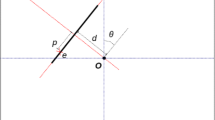Abstract
In this paper, we present a new method for segmenting closed contours and surfaces. Our work builds on a variant of the minimal path approach. First, an initial point on the desired contour is chosen by the user. Next, new keypoints are detected automatically using a front propagation approach. We assume that the desired object has a closed boundary. This a-priori knowledge on the topology is used to devise a relevant criterion for stopping the keypoint detection and front propagation. The final domain visited by the front will yield a band surrounding the object of interest. Linking pairs of neighboring keypoints with minimal paths allows us to extract a closed contour from a 2D image. This approach can also be used for finding an open curve giving extra information as stopping criteria. Detection of a variety of objects on real images is demonstrated. Using a similar idea, we can extract networks of minimal paths from a 3D image called Geodesic Meshing. The proposed method is applied to 3D data with promising results.
Similar content being viewed by others
References
Ardon, R., Cohen, L.D., Yezzi, A.: A new implicit method for surface segmentation by minimal paths in 3d images. Appl. Math. Optim. 55(18), 127–144 (2007)
Benmansour, F., Bonneau, S., Cohen, L.D.: Finding a closed boundary by growing minimal paths from a single point on 2d or 3d images. In: MMBIA07, pp. 1–8 (2007)
Bonneau, S.: Chemins minimaux en Analyse d’images: Nouvelles contributions et applications à l’imagerie biologique. PhD thesis, Université Paris-Dauphine, France (2006)
Bonneau, S., Dahan, M., Cohen, L.D.: Single quantum dot tracking based on perceptual grouping using minimal paths in a spatiotemporal volume. IEEE Trans. Image Process. 14, 1384–1395 (2005)
Caselles, V., Kimmel, R., Sapiro, G.: Geodesic active contours. Int. J. Comput. Vis. 22, 61–79 (1997)
Cohen, L.D.: Multiple contour finding and perceptual grouping using minimal paths. J. Math. Imaging Vis. 14, 225–236 (2001)
Cohen, L.D.: Minimal paths and fast marching methods for image analysis. In: Paragios, N., Chen, Y., Faugeras, O. (eds.) Mathematical Models in Computer Vision: The Handbook. Springer, Berlin (2005)
Cohen, L.D., Kimmel, R.: Global minimum for active contour models: a minimal path approach. Int. J. Comput. Vis. 24, 57–78 (1997)
Deschamps, T., Cohen, L.D.: Fast extraction of minimal paths in 3D images and applications to virtual endoscopy. Med. Image Anal. 5, 281–299 (2001)
Dijkstra, E.W.: A note on two problems in connection with graphs. Numer. Math. 1, 269–271 (1959)
Falcão, A.X., Udupa, J.K., Miyazawa, F.K.: An ultra-fast user-steered image segmentation paradigm: Live-wire-on-the-fly. IEEE Trans. Med. Imaging 19(1), 55–62 (2000)
Kass, M., Witkin, A., Terzopoulos, D.: Snakes: active contour models. Int. J. Comput. Vis. 1, 321–331 (1988)
Kim, S.: An \(\mathcal{O}({N})\) level set method for Eikonal equations. SIAM J. Sci. Comput. 22, 2178–2193 (2001)
Kimmel, R., Sethian, J.A.: Optimal algorithm for shape from shading and path planning. J. Math. Imaging Vis. 14, 237–244 (2001)
Peyré, G., Cohen, L.D.: Geodesic remeshing using front propagation. Int. J. Comput. Vis. 69, 145–156 (2006)
Rouy, E., Tourin, A.: A viscosity solution approach to shape from shading. SIAM J. Numer. Anal. 29, 867–884 (1992)
Sethian, J.A.: A fast marching level set for monotonically advancing fronts. Proc. Natl. Acad. Sci. 93, 1591–1595 (1996)
Sethian, J.A.: Fast marching methods. SIAM Rev. 41, 199–235 (1999)
Sethian, J.A.: Level Set Methods and Fast Marching Methods. Cambridge University Press, Cambridge (1999)
Tsitsiklis, J.N.: Efficient algorithms for globally optimal trajectories. IEEE Trans. Autom. Control 40, 1528–1538 (1995)
Yatziv, L., Bartesaghi, A., Sapiro, G.: \(\mathcal{O}({N})\) implementation of the fast marching algorithm. J. Comput. Phys. 212, 393–399 (2006)
Yezzi, A., Kichenassamy, S., Kumar, A., Olver, P., Tannenbaum, A.: A geometric snake model for segmentation of medical imagery. IEEE Trans. Med. Imaging 16, 199–209 (1997)
Author information
Authors and Affiliations
Corresponding author
Rights and permissions
About this article
Cite this article
Benmansour, F., Cohen, L.D. Fast Object Segmentation by Growing Minimal Paths from a Single Point on 2D or 3D Images. J Math Imaging Vis 33, 209–221 (2009). https://doi.org/10.1007/s10851-008-0131-0
Received:
Revised:
Accepted:
Published:
Issue Date:
DOI: https://doi.org/10.1007/s10851-008-0131-0




